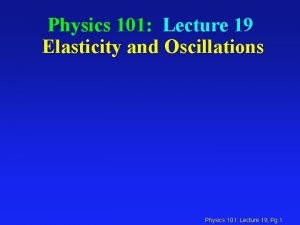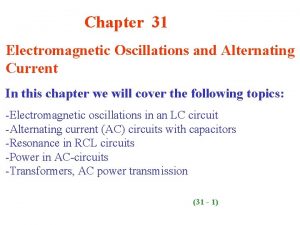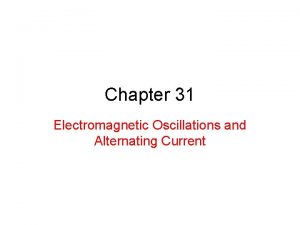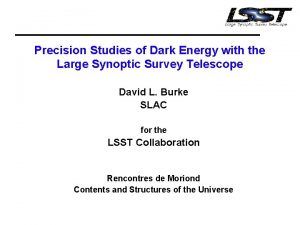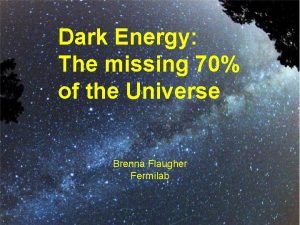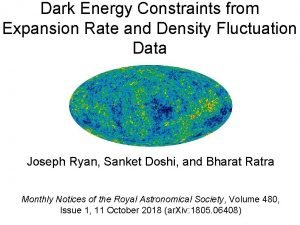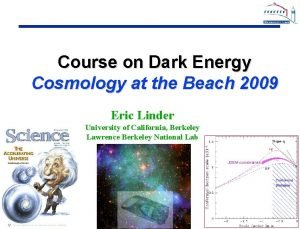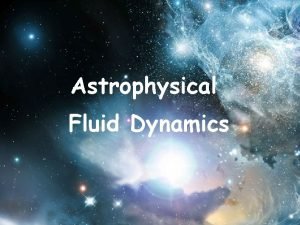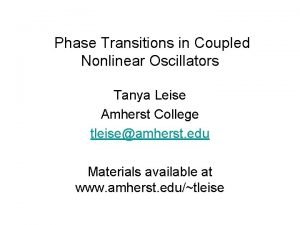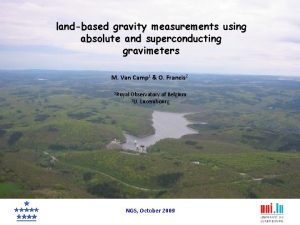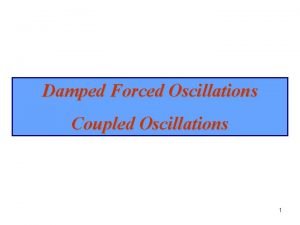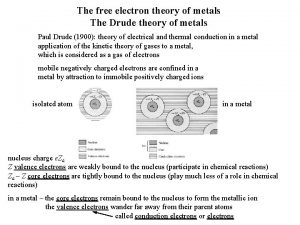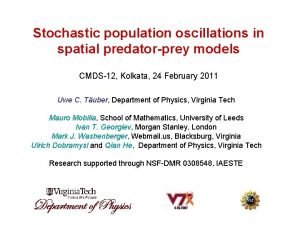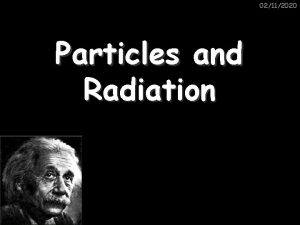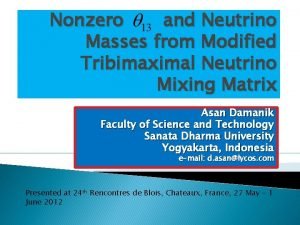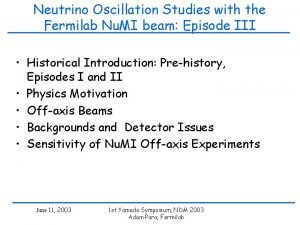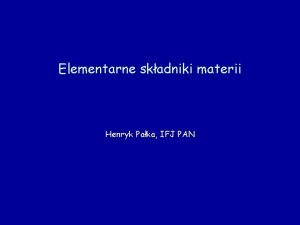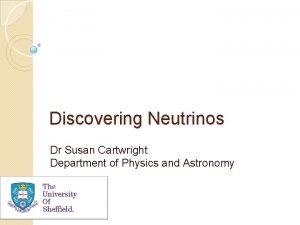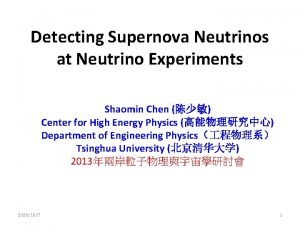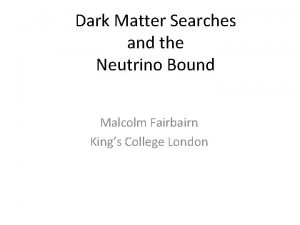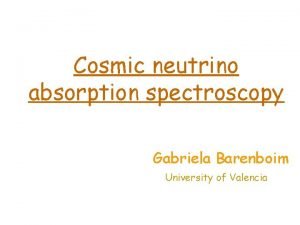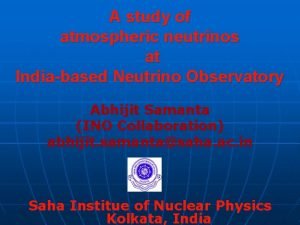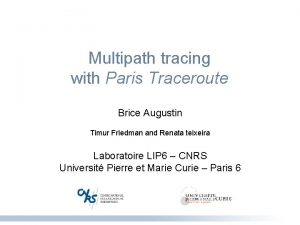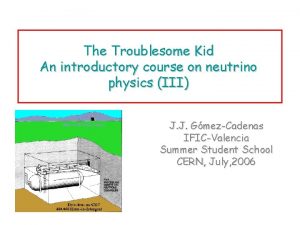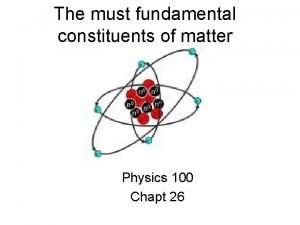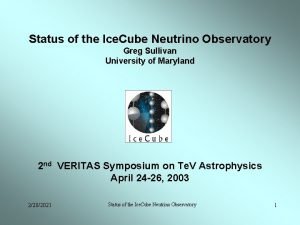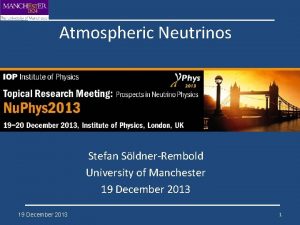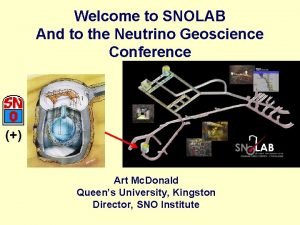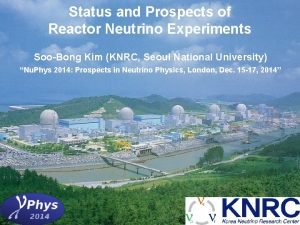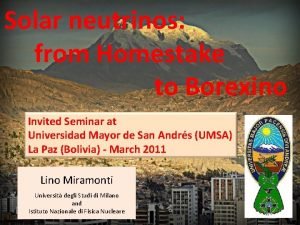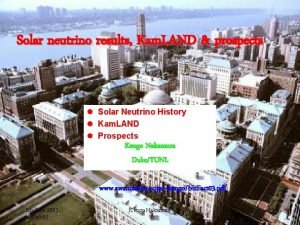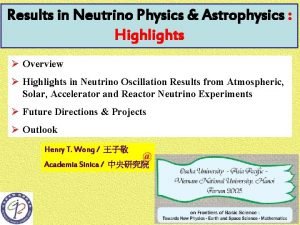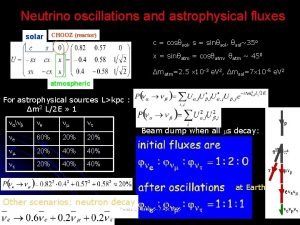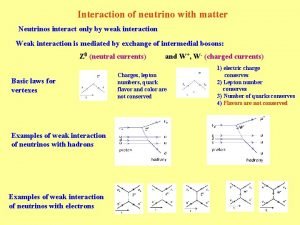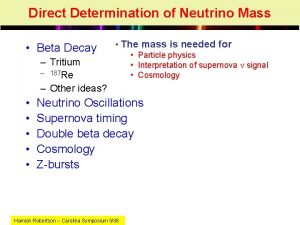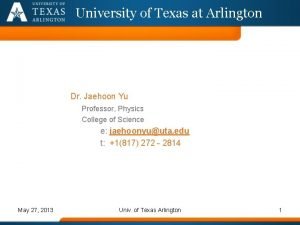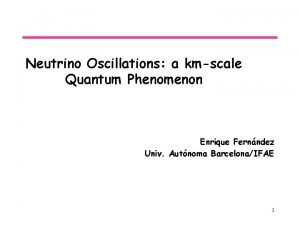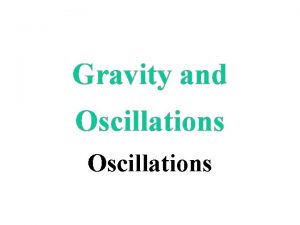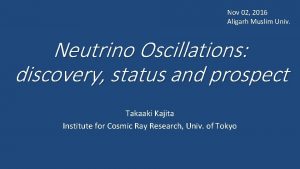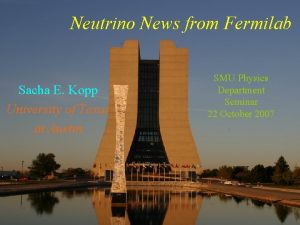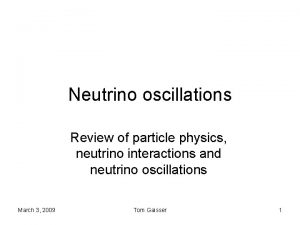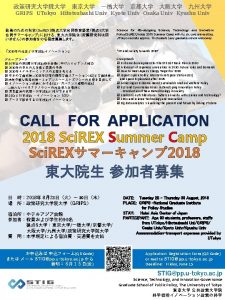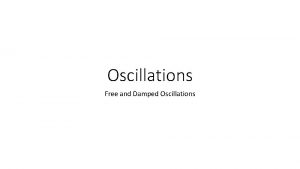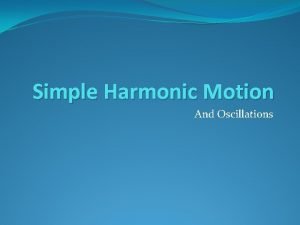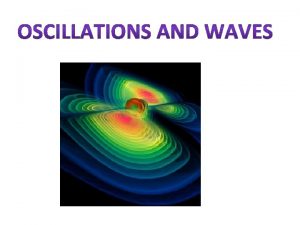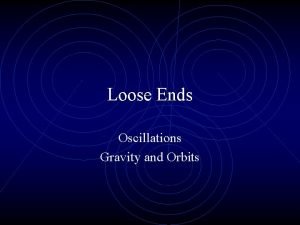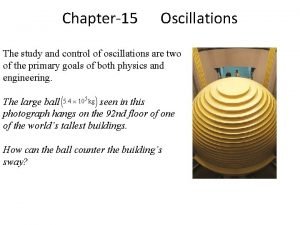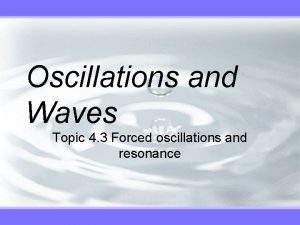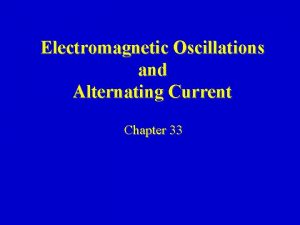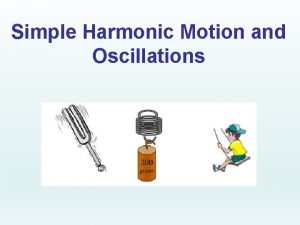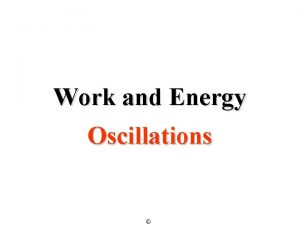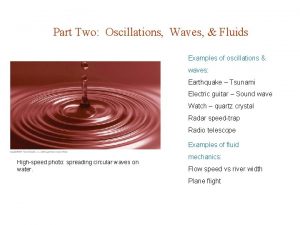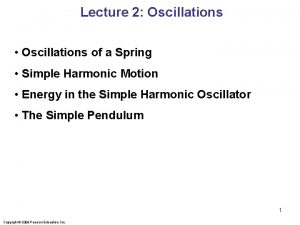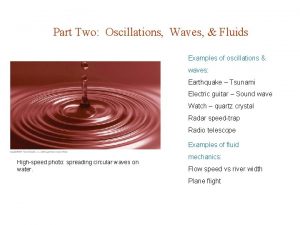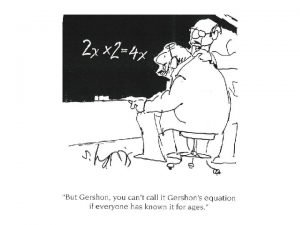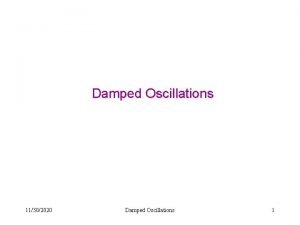Neutrino oscillations status and plans Enrique Fernndez Univ









































- Slides: 41

Neutrino oscillations: status and plans Enrique Fernández Univ. Autónoma Barcelona/IFAE Trobada de Nadal, Univ. Barcelona, Dec 21 -22, 2005 1

Neutrino properties Neutrinos are somewhat special particles. This is mainly due to the fact that they only interact weakly. At low energies (Me. V’s), the cross-section for interacting with 1 nucleon is very small, ~ 10 -40 cm 2. This implies that they are “invisible” in most cases. The charged current weak interaction is also very peculiar: it only acts on the left-handed chiral projection of particle spinors (right-handed, for antiparticles). It does not conserve P (nor CP). Spin effect are thus very strong. They also have a very small mass, compared with that of the other elementary particles. 2

Neutrino properties Quark and Lepton masses in units of Me. V/c 2 Quarks Leptones mu= 400 md= 400 me= 0. 5 mne< 0. 0000022 mc= 1, 600 ms= 500 mm= 106 mnm< 0. 000170 mt=175, 000 mb=4, 300 mt= 1, 776 mnt< 15. 5 From CMB anisotropies: Smi<0. 00000071 3

Neutrinos in the SM In the SM there are 3 lepton families, each containing a charged lepton and a neutrino. Neutrinos are massless particles and each family lepton number (as well as global lepton number) is conserved. The neutrino has three states (weak eigenstates): ne, nm, nt. By definition these are the states that couple to the W together with the corresponding charged leptons. These assumptions, in particular the massless assumption, were built up from experiments. 4

Massive neutrinos and neutrino oscillations In 1998 there was a turning point in neutrino physics. Data from atmospheric neutrinos collected by the Superkamiokande detector showed that there were neutrino oscillations. As we will see neutrino oscillations requires that neutrinos have mass and that there is lepton mixing. The SK results were preceded by many experiments on solar neutrinos that showed a deficit, with respect to solar models, on the number of neutrinos coming from the Sun. New solar neutrino experiments, in particular SNO (Sudbury Neutrino Observatory) have now shown unequivocally that the deficit of solar neutrinos is also due to oscillations. 5

What do we mean by oscillations? (ref. : B. Kaiser, hep-ph/0506165). Let’s assume that a neutrino of flavor a, na, is produced at the source. When it interacts at the target it does so as a neutrino of a different flavor, nb. 6

Neutrino Oscillations: Oscillation requires both mixing between the leptons and massive neutrinos. Suppose that there are several neutrino mass states ni. Mixing means that the state produced together with charged lepton la is a superposition of different ni: U*ai= amplitude of W+ decay to la ni The set of all U*ai (for 3 ni) form a unitary matrix. Inverting it: Pontecorvo-Maki-Nakagawa-Sakata matrix 7

Neutrino Oscillations: The oscillation probability is given by the square of the amplitude: 8

Neutrino Oscillations: In the n rest frame: In terms of laboratory variables: To interfere coherently, the different ni have to have the same E. (if they had the same p the phase would be exp (-i(Ei-Ej)t) which, averaged over t, would be zero, unless Ei=Ej). The momentum is given by (for mi 2<<E 2): Therefore the phase is: (constant for all ni, thus not contributing to the probability) 9

Neutrino oscillations. Squaring the amplitude: The oscillation implies that lepton family number is no longer conserved. 10

Neutrino Oscillations: This is entirely similar to what happens in the case of the quarks, where favor is not conserved in weak decays, e. g L (uds) p (uud)+ p- (du) The reason for the non-conservation of “quark family number” or “flavor” is quark mixing, the fact that weak and mass eigenstates are different. u d’ c s’ t b’ The difference is that we produce weak-interaction quarks (in the weak decay of the L) but observe them as mass states (in the p or p). 11

Neutrino oscillations. Squaring the amplitude: From this expression we see that: 1) as required by CPT invariance. 2) In general (if U complex): CP violation. 3) The sin 2[. . L/E] gives “oscillatory” pattern. The above formula is very complicated but nature has been kind enough as to make it simple in certain cases of interest. 12

Neutrino oscillation: To gain some understanding of the above formula write: For a given term to be relevant the argument of sin 2() should not be much smaller than p/2, otherwise sin 2( ) is too small. It can also be that for a given experiment only one mixing angle is relevant. The bottom line is that in some cases the oscillation can be treated as a two-family mixing. 13

Neutrino oscillation: Oscillation probabilities (2 neutrino case; relevant for CNGS beam): 14

The first clear signature of oscillations came from the Super. Kamiokande experiment in 1998 15

Super. Kamiokande detector principle Detect Cherenkov light produced by charged lepton l from reacction n+N l +X (l =e, m), or e- from n+e-. Detector operates in real time and has directional information. 16

Super. Kamiokande events (fairly typical) muon electron 17

Evidence for neutrino oscillations SK atmospheric n 18

The evidence for oscillations: solar neutrinos The flux of solar neutrinos is very large but their detection is very difficult. The pioneer experiment of R. Davies took place at the Homestake Mine in S. Dakota (at 1350 m depth). Large (600 tons) of Perchloroethylene (C 2 Cl 4). The detection method is radiochemical. About 2 radioactive atoms/day! 22

The evidence for oscillations: solar neutrinos The measurement was repeated by other experiments using Galium instead of Clorine. All of them saw less neutrinos than expected. This was known as the “solar neutrino problem”. Kamiokande, and later SK, measured the “elasticscattering” reaction e- ne ne n x + e- → n x + ewhere nx is mostly ne. W e- nm, t Z e- e- ne Z e- ne nm, t e- 23

The evidence for oscillations: solar neutrinos 24

The evidence for oscillations: solar neutrinos 25

Definive solution of the Solar neutrino puzzle The Sudbury Neutrino Observatory (SNO) SNO: 1 k. T of D 2 O (heavy water) surrounded by 7. 8 k. T of ultra pure H 2 O. Located at 2000 m depth at the INCO mine in Sudbury, Ontario, Canada. 26

Definive solution of the Solar neutrino puzzle SNO A neutrino of En>2. 2 Me. V can disociate the Deuterium nucleous, into proton and neutron. This NC process takes place for any neutrino species. SNO detects 3 reactions: ne + D p + e - (CC) n x + e- → n x + e- (ES; like SK) nl + D nl + p + n (NC; l = e, m, t) The neutron is captured producing 6. 25 Me. V. But detecting a single neutron is difficult. . . 27

Definive solution of the Solar neutrino puzzle SNO Results 28

Oscillation signatures Atmospheric neutrino disappear, but, is it due to oscillations? A controlled accelerator experiment: K 2 K (KEK to Kamioka). 29

K 2 K (KEK to Kamioka) ~1 event/2 days ~1011 nm/2. 2 sec (/10 m 10 m) 1º tilt downwards 12 Ge. V protons p+ ~106 nm/2. 2 sec nm (/40 m 40 m) SK nt m+ Target+Horn p monitor 200 m decay pipe m monitor 100 m ~250 km Near n detectors (ND) (monitor the beam center) Signal of n oscillation at K 2 K Reduction of nm events l Distortion of nm energy spectrum l 30

GPS SK Events Tspill TOF=0. 83 msec SK TSK Decay electron cut. 500 msec 20 Me. V Deposited Energy No Activity in Outer Detector Event Vertex in Fiducial Volume More than 30 Me. V Deposited Energy 107 events 5 msec Analysis Time Window for 0. 89 x 1020 p. o. t. -0. 2<TSK-Tspill-TOF<1. 3 msec (BG: 1. 6 events within 500 ms 2. 4× 10 -3 events in 1. 5 ms) TDIFF. (ms) 31

K 2 K near-detector complex • • • 1 KT Water Cherenkov Detector (1 KT) Scintillating-fiber/Water sandwich Detector (Sci. Fi) Lead Glass calorimeter (LG) before 2002 Scintillator Bar Detector (Sci. Bar) after 2003 Muon Range Detector (MRD) 32

Oscillation signatures E. Aliu et al. , Phys. Rev. Letters 94: 081802, 2005. 35

KAMLAND Reactor Experiment “Solar” neutrino oscillations in a controlled reactor-experiment 36

Evidence for neutrino oscillations SK atmospheric n K 2 K Solar experiments KAMLAND reactor exp. 37

Neutrino oscillations: In addition to the Solar (+Kamland) and Atmospheric (+K 2 K), there are two other very relevant experiments: Chooz reactor experiment. Sees no oscillation of reactor ne over a baseline of 1 Km. LSND accelerator experiment. Sees positive signal of oscillations of nm → ne over 30 m baseline conveniently ignored Excess of 87. 9± 22. 4± 6. 0 events! 38

Results of the analysis of the oscillation data 39

Results of the analysis of the oscillation data 40

Oscillation parameters Dm 2 atm≡ Dm 232=m 23 -m 22 = [(2. 4 0. 3)x 10 -3 e. V 2] dm 2 sol≡ Dm 221=m 22 -m 21 = (0. 8 0. 3)x 10 -5 e. V 2 n 1 2/3 ne n 2 1/3 ne n 3 0% ne Mixing angles: q 12 qsol 34º 2º q 23 qatm 45º 3º q 13 < 12º (at 3 s) sin 2 q 13≡|Ue 3|2 < 0. 04 41

Parameterization of the PMNS matrix In view of the results it is convenient to parameterize the PMNS matrix as: atmospheric CP violation phase solar Links atmospheric & solar sectors cij≡cosqij sij≡sinqij 42

Solar Oscillations and the MSW effect The solar neutrinos pass through the very dense Sun core. Electron neutrinos can interact forward with the solar matter in two ways, while mu or tau neutrinos only do so through NC. ne, m, t Z e e ne W e e ne Forward interactions cannot be distinguished from no-interaction at all coherent scattering, which affects propagation through matter. The extra term for ne gives an extra phase to mass eigenstates which interplays with that which gives rise to oscillations. The effect has the opposite sign for neutrinos and antineutrinos (has nothing to do with CP violation). 43

Solar Oscillations and the MSW effect Formulae are similar to those in vacuum with the replacement: + for neutrinos - for antineutrinos x < cos 2 q 12 sign of x depends on sign of Dm 2 x>1 Pee E 1 Me. V 44

Accelerator experiments and their primary goals: Mini. Boone (FNAL): prove or disprove LSND K 2 K (KEK-Kamioka): check SK, improve Dm MINOS (FNAL-Soudan) check SK, improve Dm, q 13? OPERA (CERN-LNGS) see nt appearance in nm beam T 2 K (KEK-Kamioka) try to measure q 13. . . Nona (FNAL-Nth Minn. ) try to measure q 13. . . Many ideas for future q 13, CP-violation, . . . Near Term Longer Term 45

Conclusions • Neutrinos played a crucial role in establishing the Standard Model. • Neutrinos have mass and mix. This is physics beyond the Standard Model. • The masses and pattern of mixing is quite different from that of quarks. This may be a hint to the physics beyond the SM. • Accelerator experiments permit the control of E, L and the initial neutrino state. They will have a role in elucidating fully the pattern of masses and mixings. • Progress will require a variety of experiments at different energies and baselines. 46
 Alejandro fernndez
Alejandro fernndez Alejandro fernndez
Alejandro fernndez Elasticity and oscillations
Elasticity and oscillations Electromagnetic oscillations and alternating current
Electromagnetic oscillations and alternating current Electromagnetic oscillations and alternating current
Electromagnetic oscillations and alternating current Baryon acoustic oscillations
Baryon acoustic oscillations Joint play definition
Joint play definition Universe expanding faster should
Universe expanding faster should Baryon acoustic oscillations
Baryon acoustic oscillations Baryon acoustic oscillations
Baryon acoustic oscillations Baryonic acoustic oscillations
Baryonic acoustic oscillations Tanya leise amherst
Tanya leise amherst Slow oscillations
Slow oscillations Coupled oscillations
Coupled oscillations Drude free electron theory
Drude free electron theory Plasma oscillations
Plasma oscillations Lotka-volterra predator-prey model
Lotka-volterra predator-prey model Dotterkärna
Dotterkärna Neutrino lepton number
Neutrino lepton number Lepton number table
Lepton number table Neutrino
Neutrino Neutrino
Neutrino Lekka cząstka elementarna mion elektron lub neutrino
Lekka cząstka elementarna mion elektron lub neutrino Dr susan cartwright
Dr susan cartwright Neutrino
Neutrino Neutrino
Neutrino Neutrino density
Neutrino density Neutrino
Neutrino Paris traceroute
Paris traceroute Neutrino
Neutrino Neutrino symbol
Neutrino symbol Ice cube para status
Ice cube para status Neutrino
Neutrino Cerenkov
Cerenkov Neutrino
Neutrino Solar neutrino
Solar neutrino Nakamura
Nakamura Neutrino mass
Neutrino mass Neutrino
Neutrino Neutrino interaction with matter
Neutrino interaction with matter Neutrino mass
Neutrino mass Ut arlington demographics
Ut arlington demographics


